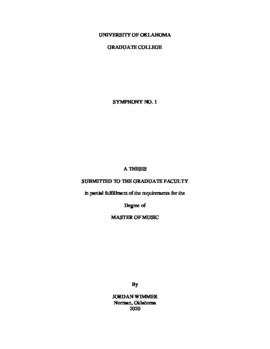| dc.description.abstract | Symphony No. 1 is a symphony in four movements consisting of movement 1, which is an ABCAD allegro with an introduction; Movement 2, which is an ABA largo; movement 3, which is a Minuet & Trio; and Movement 4, a third rondo with a coda.
The structural and artistic rationale for this symphony is a rhythmic idea, with inspiration drawn from the central motivic idea of Beethoven's Symphony No. 5 in C Minor, Op 67. This rhythmic idea is centered around placing sixteenth notes within a quarter note span. Specifically, if you have all four sixteenth notes that make up a quarter note together, then you take away one, there are four different rhythms you can end up with depending on which of the four sixteenth notes you remove. You can get a 1 & a, 1 e &, 1 e a, or an e & a rhythm; each movement is based on one of these different permutations.
The first movement uses the 1 e & rhythm, the second movement uses the e & a rhythm, the third movement uses the 1 e a rhythm, and the final movement uses the 1 & a rhythm. Furthermore, the fourth movement has a few moments where all four ideas are used in sequence, in the order presented through each of the movements. Of course, while these rhythms were conceived on the sixteenth-note level, the rhythms are expanded throughout the symphony, being employed at the eighth-note, quarter, all the way up to the double-whole-note level. In summary, the various permutations of three sixteenth note lengths within the span of a quarter note length is the central idea of the piece.
This symphony draws its tonal inspiration from Beethoven's Fifth Symphony. The first movement is an allegro in the tonality of E with an emphasis on the minor mode. The following slow movement begins in the tonality of C, which is a major third below the E tonality. This is reflective of Beethoven's Fifth descent a major third in its second movement to the tonic of A-flat. The third movement returns to an E tonality with an emphasis on the minor mode. The finale is in the tonality of E and in a major mode, which mirrors Beethoven's build to the parallel major of C in the finale of Symphony No. 5.
The symphony is written for the instrumentation of a late 19th-century orchestra. The instrumentation is: woodwinds: 2d picc, 2, 2, 2+contra; brass: 4, 2, 2; percussion: timpani, xylophone, snare drum, bass drum, hand held cymbals; harp; strings. It should be noted that the harp is absent in movement four and that the xylophone is only in the third movement. | en_US |

